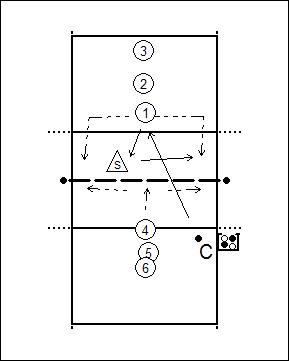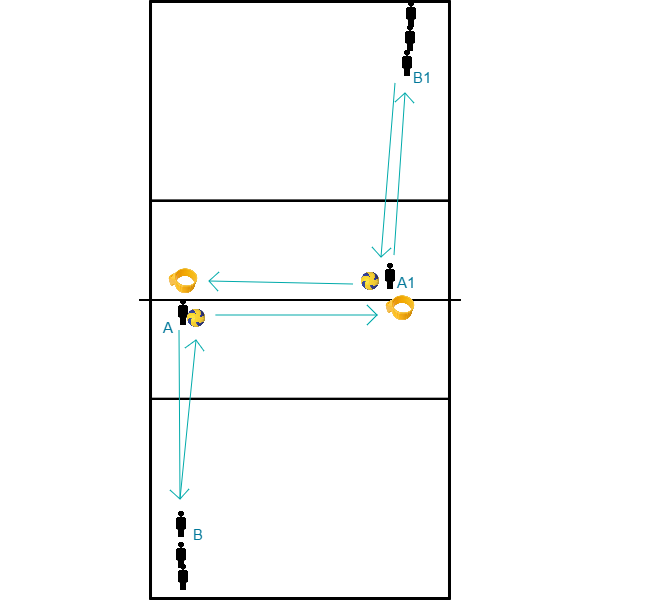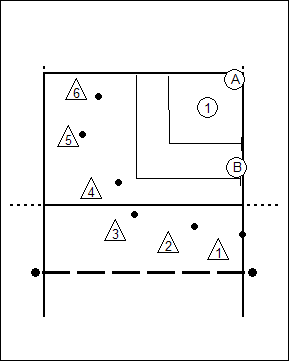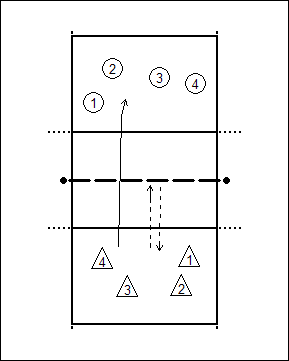Volleyball drills
- bring the ball into the game; S sets up to left forward
- 1 diagonal attack
- all rotate one spot when ball is over the net
- defend diagonal attack on set-upper
- set up to left forward, attack diagonally; etc.
POINTS OF ATTENTION:
- when rotating, quickly to starting position
- all provide attack defense
- right forward block put straight

line of attackers on the 3 meter line
-C plays rally ball on attacker 1
- blocker 4 goes to the net
- 1 passes to S and calls where he wants the set up
(left, middle, or right)
- blocker follows attacker and blocks
- attacker gets ball, joins back of own line
- if the attackers score 10x, the attackers and
blockers change


Moving as long as you can is for me the moment the attacker is about to hit the ball. At that moment the defender makes a split step and you make sure the focus of your body is being brought forward. So do not move backwards when the ball is hit, because your focus point is behind you and you will be too late to defend the ball before you. If the ball is defended, finish rally. |
- A serves to B.
- B passes the ball to the playmaker, who then plays a high ball in the back field.
- B defends this ball back to the playmaker, which gives a set up for A.
- A attacks to this set up.
After the attack, A takes the place of B, and B will be reserve. The playmaker remains.
The outside attackers use one playmaker and the left side of the field. The centre attackers and the diagonal attackers use the right side with a different playmaker.
Expansion:
- After the service, A takes a second ball.
- After the attack of B, A throws this ball into the field.
- B plays this ball to the playmaker, the playmaker gives a set up
- B attacks again.

Pass and overarm exercise
- Player A and A1 have the ball.
- This player throws the ball to player B/B1
- Player B/B1 passes the ball back 'perfectly'
- Player A/A1 then plays the ball in the basket.
- Player A/A1 picks up the ball and joins the back of the line. You follow your ball
The tempo is automatic and can be increased. Make it harder by letting player B pass elsewhere, so player A has aim for the basket. Other option: Player A throws to a more difficult spot in the field.

- defends box A (hard attack) and B (tactical ball) - rest attacks in sequence ( alternating hard and tactical)

- 2 teams behind the three meter line - defend, set up, and three meter attack - when you have played the ball, you sprint to the net VARIATION: instead of sprint: block at the net duik naar achterlijn aanvalssprong

| If you put pressure on the opponent with your service and attack, the balls easily get over the net. It is a must to process these balls properly and (quickly) set up another attack. Precision is of the highest importance. The responsibilities have to be clear and taken by the players. It has to be clear for whom the easy ball is and who passes it. The place to which the ball is passed must also be clear. The speed of the rally pass is also of importance. Particularly when the playmaker is forward, you can pass the ball quicker to the net. Closer to the net, you pass the ball a bit higher, so everybody has time to prepare for the attack. The exercise: Coach throws ball in to the six. They build up an attack The six have to score from the rally pass. The four have to prevent this by blocking the ball and defend. When the 6 have 5 points, change. score keeping:
|
If volleyball players think they are starting the attack pass to soon, or the trainer thinks the attackers come in too soon, this is a good exercise.
The playmaker is positioned with a box of balls. He has to throw up the ball for himself 5 times or less. The attackers doe not know how often this happens, and can only leave when the set-up is done, not before.
The attackers will have to come in more aggressively, building up more speed and thus more height, if there is a good brake pass.
If this goes well, the trainer can decide to move the playmaker closer to the attackers, so the distance the set-upper has to cover is shortened. The attackers have to be even more alert.
In a large circle:
- Turn ankles
- Spread arms and make small circles, increasing in size. Then back again. Start large, and then make smaller and smaller rounds
- Airplane. 10 seconds on every leg.
- Planking: 30 seconds or 1 minute
- 9 hoops in a square (3x3)
- 2 groups of 3
- everybody a vest/cloth
- every team their own color
- first 2 of each group sprint to the hoops
- put their cloth in a hoop
- run back and tag the next
- the goal is to get 3 in a row
- if everybody has done it 1x, no cloths with be left
- everybody runs one more time, and now you can move a cloth
- the winner is the one who has 3 in a row the first, OR who is back the first (winning the relay race 2x)
Back muscles. Lie down flat on the floor face down. Place your hands on your back, and slowly get up as far as you can. Breathe out when you get up, and breathe in when you lie down again. Keep your eyes on the floor. We do this exercise 20 times.
Stomach muscles. After the last exercise, we turn around and lie on our backs face upwards. Grab your partner and take place opposite him. Take a ball and throw it at the moment you clench both stomach muscles and get up. If this goes well, we increase the tempo









